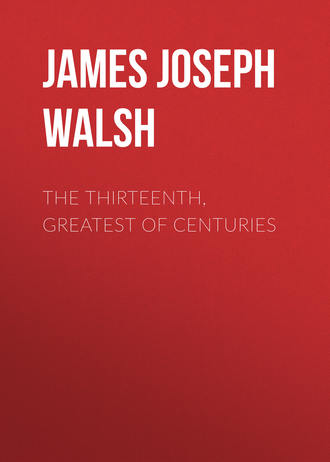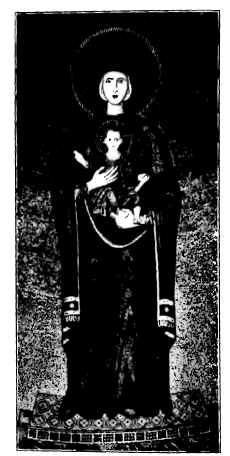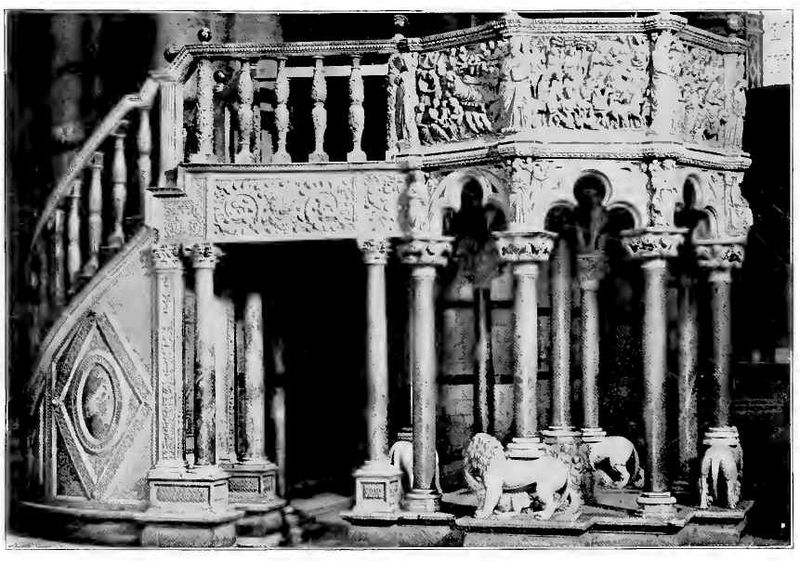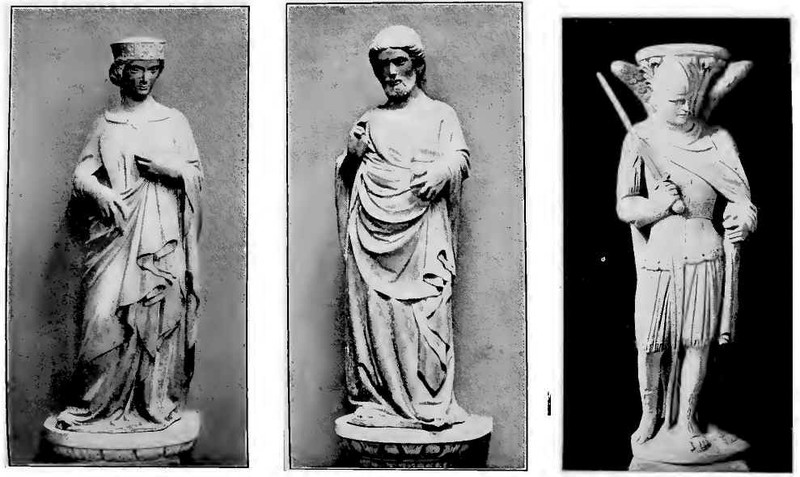 полная версия
полная версияThe Thirteenth, Greatest of Centuries
In the things of the spirit apparently there is very little, if any, evolution. Homer wrote nearly three thousand years ago as supreme an expression of human life in absolute literary values as the world has ever known, or, with all reverence for the future be it said, is ever likely to know. The great dramatic poem Job emanated from a Hebrew poet in those earlier times, and yet, if judged from the standpoint of mere literature, is as surpassing an expression of human intelligence in the presence of the mystery of evil as has ever come from the mind of man. We are no nearer the solution of the problem of evil in life, though thousands of years have passed and man has been much occupied with the thoughts that disturbed the mind of the ruler of Moab. The Code of Hammurabi, recently discovered, has shown very definitely, that men could make laws nearly five thousand years ago as well calculated to correct human abuses as those our legislators spend so much time over at present, and the olden time laws were probably quite as effective as ours can hope to be, for all our well intentioned purpose and praiseworthy efforts at reform.
It used to be a favorite expression of Virchow, the great German pathologist, who was, besides, however, the greatest of living anthropologists, that from the history of the human race the theory of evolution receives no confirmation of any kind. His favorite subject, the study of skulls, and their conformation in the five thousand years through which such remains could be traced, showed him absolutely no change. For him there had been also no development in the intellectual order in human life during the long period of human history. Of course this is comparatively brief if the long aeons of geological times be considered, yet some development might be expected to manifest itself in the more than two hundred generations that have come and gone since the beginning of human memory. Perhaps, then, the prejudice with regard to evolution and its supposed effectiveness in making the men of more recent times superior to those of the past, may be considered to have very little weight as an a priori objection to the consideration of the Thirteenth Century as representing the highest stage in human accomplishment. So far as scientific anthropology goes there is utter indifference as to the period that may be selected as representing man at his best.
To most people the greater portion of surprise with regard to the assertion of the Thirteenth as the greatest of centuries will be the fact that the period thus picked out is almost in the heart of the Middle Ages. It would be not so amazing if the fifth century before Christ, which produced such marvelous accomplishments in letters and art and philosophy among the Greeks, was chosen as the greatest of human epochs. There might not even be so much of unpreparedness of mind if that supreme century of Roman History, from fifty years before Christ to fifty years after, were picked out for such signal notice.

VIRGIN WITH THE DIVINE CHILD (MOSAIC, ST. MARK'S, VENICE)
We have grown accustomed, however, to think of the Middle Ages as hopelessly backward in the opportunities they afforded men for the expression of their intellectual and artistic faculties, and above all for any development of that human liberty which means so much for the happiness of the race and must constitute the basis of any real advance worth while talking about in human affairs. It is this that would make the Thirteenth Century seem out of place in any comparative study for the purpose of determining proportionate epochal greatness. The spirit breathes where it will, however, and there was a mighty wind of the spirit of human progress abroad in that Thirteenth Century, whose effects usually miss proper recognition in history, because people fail to group together in their minds all the influences in our modern life that come to us from that precious period. All this present volume pretends to do is to gather these scattered details of influence in order to make the age in which they all coincided so wonderfully, be properly appreciated.
If we accept the usual historical division which places the Middle Ages during the thousand years between the fall of the Roman Empire, in the Fifth Century and the fall of the Grecian Empire of Constantinople, about the middle of the Fifteenth, the Thirteenth Century must be considered the culmination of that middle age. It is three centuries before the Renaissance, and to most minds that magical word represents the beginning of all that is modern, and therefore all that is best, in the world. Most people forget entirely how much of progress had been made before the so-called Renaissance, and how many great writers and artists had been fostering the taste and developing the intelligence of the people of Italy long before the fall of Constantinople. The Renaissance, after all, means only the re-birth of Greek ideas and ideals, of Greek letters and arts, into the modern world. If this new birth of Greek esthetics had not found the soil thoroughly prepared by the fruitful labor of three centuries before, history would not have seen any such outburst of artistic and literary accomplishments as actually came at the end of the Fifteenth and during the Sixteenth centuries.
In taking up the thesis, The Thirteenth the Greatest of Centuries, it seems absolutely necessary to define just what is meant by the term great, in its application to a period. An historical epoch, most people would concede at once, is really great just in proportion to the happiness which it provides for the largest possible number of humanity. That period is greatest that has done most to make men happy. Happiness consists in the opportunity to express whatever is best in us, and above all to find utterance for whatever is individual. An essential element in it is the opportunity to develop and apply the intellectual faculties, whether this be of purely artistic or of thoroughly practical character. For such happiness the opportunity to rise above one's original station is one of the necessary requisites. Out of these opportunities there comes such contentment as is possible to man in the imperfect existence that is his under present conditions.
Almost as important a quality in any epoch that is to be considered supremely great, is the difference between the condition of men at the beginning of it and at its conclusion. The period that represents most progress, even though at the end uplift should not have reached a degree equal to subsequent periods, must be considered as having best accomplished its duty to the race. For purposes of comparison it is the amount of ground actually covered in a definite time, rather than the comparative position at the end of it, that deserves to be taken into account. This would seem to be a sort of hedging, as if the terms of the comparison of the Thirteenth with other centuries were to be made more favorable by the establishment of different standards. There is, however, no need of any such makeshift in order to establish the actual supremacy of the Thirteenth Century, since it can well afford to be estimated on its own merits alone, and without any allowances because of the stage of cultural development at which it occurred.
John Ruskin once said that a proper estimation of the accomplishments of a period in human history can only be obtained by careful study of three books—The Book of the Deeds, The Book of the Arts, and the Book of the Words, of the given epoch. The Thirteenth Century may be promptly ready for this judgment of what it accomplished for men, of what it wrote for subsequent generations, and of the artistic qualities to be found in its art remains. In the Book of the Deeds of the century what is especially important is what was accomplished for men, that is, what the period did for the education of the people, not alone the classes but the masses, and what a precious heritage of liberty and of social coordination it left behind. To most people it will appear at once that if the most important chapter of Thirteenth Century accomplishment is to be found in the Book of its Deeds and the deeds are to be judged according to the standard just given of education and liberty, then there will be no need to seek further, since these are words for which it is supposed that there is no actual equivalent in human life and history for at least several centuries after the close of the Thirteenth.
As a matter of fact, however, it is in this very chapter that the Thirteenth Century will be found strongest in its claim to true greatness. The Thirteenth Century saw the foundation of the universities and their gradual development into the institutions of learning which we have at the present time. Those scholars of the Thirteenth Century recognized that, for its own development and for practical purposes, the human intellect can best be trained along certain lines. For its preliminary training, it seemed to them to need what has since come to be called the liberal arts, that is, a knowledge of certain languages and of logic, as well as a thorough consideration of the great problems of the relation of man to his Creator, to his fellow-men, and to the universe around him. Grammar, a much wider subject than we now include under the term, and philosophy constituted the undergraduate studies of the universities of the Thirteenth Century. For the practical purposes of life, a division of post-graduate study had to be made so as to suit the life design of each individual, and accordingly the faculties of theology, for the training of divines; of medicine, for the training of physicians; and of law, for the training of advocates, came into existence.
We shall consider this subject in more detail in a subsequent chapter, but it will be clear at once that the university, as organized by these wise generations of the Thirteenth Century, has come down unchanged to us in the modern time. We still have practically the same methods of preliminary training and the same division of post-graduate studies. We specialize to a greater degree than they did, but it must not be forgotten that specialism was not unknown by any means in the Thirteenth Century, though there were fewer opportunities for its practical application to the things of life. If this century had done nothing else but create the instrument by which the human mind has ever since been trained, it must be considered as deserving a place of the very highest rank in the periods of human history.
It is, however, much more for what it accomplished for the education of the masses than for the institutions it succeeded in developing for the training of the classes, that the Thirteenth Century merits a place in the roll of fame. This declaration will doubtless seem utterly paradoxical to the ordinary reader of history. We are very prone to consider that it is only in our time that anything like popular education has come into existence. As a matter of fact, however, the education afforded to the people in the little towns of the Middle Ages, represents an ideal of educational uplift for the masses such as has never been even distantly approached in succeeding centuries. The Thirteenth Century developed the greatest set of technical schools that the world has ever known. The technical school is supposed to be a creation of the last half century at the outside. These medieval towns, however, during the course of the building of their cathedrals, of their public buildings and various magnificent edifices of royalty and for the nobility, succeeded in accomplishing such artistic results that the world has ever since held them in admiration, and that this admiration has increased rather than diminished with the development of taste in very recent years.
Nearly every one of the most important towns of England during the Thirteenth Century was erecting a cathedral. Altogether some twenty cathedrals remain as the subject of loving veneration and of frequent visitation for the modern generation. There was intense rivalry between these various towns. Each tried to surpass the other in the grandeur of its cathedral and auxiliary buildings. Instead of lending workmen to one another there was a civic pride in accomplishing for one's native town whatever was best.

PULPIT (PISANO, SIENA)
Each of these towns, then, none of which had more than twenty thousand inhabitants except London, and even that scarcely more, had to develop its own artist-artisans for itself. That they succeeded in doing so demonstrates a great educational influence at work in arts and crafts in each of these towns. We scarcely succeed in obtaining such trained workmen in proportionately much fewer numbers even with the aid of our technical schools, and while these Thirteenth Century people did not think of such a term, it is evident that they had the reality and that they were able to develop artistic handicraftsmen—the best the world has ever known.
With all this of education abroad in the lands, it is not surprising that great results should have flowed from human efforts and that these should prove enduring even down to our own time. Accomplishments of the highest significance were necessarily bound up with opportunities for self-expression, so tempting and so complete, as those provided for the generations of the Thirteenth Century. The books of the Words as well as of the Arts of the Thirteenth Century will be found eminently interesting, and no period has ever furnished so many examples of wondrous initiative, followed almost immediately by just as marvelous progress and eventual approach to as near perfection as it is perhaps possible to come in things human. Ordinarily literary origins are not known with sufficient certainty as to dates for any but the professional scholar to realize the scope of the century's literature. Only a very little consideration, however, is needed to demonstrate how thoroughly representative of what is most enduring in literary expression in modern times, are the works in every country that had origin in this century.
There was not a single country in civilized Europe which did not contribute its quota and that of great significance to the literary movement of the time. In Spain there came the Cid and certain accompanying products of ballad poetry which form the basis of the national literature and are still read not only by scholars and amateurs, but even by the people generally, because of the supreme human interest in them. In England, the beginning of the Thirteenth Century saw the putting into shape of the Arthur Legends in the form in which they were to appeal most nearly to subsequent generations. Walter Map's work in these was, as we shall see, one of the great literary accomplishments of all time. Subsequent treatments of the same subject are only slight modifications of the theme which he elaborated, and Mallory's and Spenser's and even our own Tennyson's work derive their interest from the humanly sympathetic story, written so close to the heart of nature in the Thirteenth Century that it will always prove attractive.
In Germany, just at the same time, the Nibelungen-Lied was receiving the form in which it was to live as the great National epic. The Meistersingers also were accomplishing their supreme work of Christianizing and modernizing the old German and Christian legends which were to prove such a precious heritage of interest for posterity. In the South of Germany the Minnesingers sang their tuneful strains and showed how possible it was to take the cruder language of the North, and pour forth as melodious hymns of praise to nature and to their beloved ones as in the more fluent Southern tongues. Most of this was done in the old Suabian high German dialect, and the basis of the modern German language was thus laid. The low German was to prove the vehicle for the original form of the animal epic or stories with regard to Reynard, the Fox, which were to prove so popular throughout all of Europe for all time thereafter.
In North France the Trouvères were accomplishing a similar work to that of the Minnesingers in South Germany, but doing it with an original genius, a refinement of style characteristic of their nation, and a finish of form that was to impress itself upon French literature for all subsequent time. Here also Jean de Meun and Guillaume de Lorris wrote the Romance of the Rose, which was to remain the most popular book in Europe down to the age of printing and for some time thereafter. At the South of France the work of the Troubadours, similar to that of the Trouvères and yet with, a spirit and character all its own, was creating a type of love songs that the world recurs to with pleasure whenever the lyrical aspect of poetry becomes fashionable. The influence of the Troubadours was to be felt in Italy, and before the end of the Thirteenth Century there were many writers of short poems that deserve a place in what is best in literature. Men like Sordello, Guido Cavalcanti, Cino da Pistoia, and Dante da Maiano, deserve mention in any historical review of literature, quite apart from the influence which they had on their great successor, the Prince of Italian poets and one of the immortal trio of the world's supreme creative singers—Dante Alighieri. With what must have seemed the limit of conceit he placed himself among the six greatest poets, but posterity breathes his name only with those of Homer and Shakespeare.
Dante, in spite of his giant personality and sublime poetic genius, is not an exception nor a solitary phenomenon in the course of the century, but only a worthy culmination of the literary movement which, beginning in the distant West in Spain and England, gradually worked eastward quite contrary to the usual trend of human development and inspired its greatest work in the musical Tuscan dialect after having helped in the foundation of all the other modern languages. Dante is the supreme type of the Thirteenth Century, the child of his age, but the great master whom medieval influences have made all that he is. That he belongs to the century there can be no doubt, and of himself alone he would be quite sufficient to lift any period out of obscurity and place it among the favorite epochs, in which the human mind found one of those opportune moments for the expression of what is sublimest in human thought.
It is, however, the bock of the Arts of the Thirteenth Century that deserves most to be thumbed by the modern reader intent on learning something of this marvelous period of human existence. There is not a single branch of art in which the men of this generation did not accomplish excelling things that have been favorite subjects for study and loving imitation ever since. Perhaps the most marvelous quality of the grand old Gothic cathedrals, erected during the Thirteenth Century, is not their impressiveness as a whole so much as their wonderful finish in detail. It matters not what element of construction or decoration be taken into consideration, always there is an approach to perfection in accomplishment in some one of the cathedrals that shows with what thoroughness the men of the time comprehended what was best in art, and how finally their strivings after perfection were rewarded as bountifully as perhaps it has ever been given to men to realize.
Of the major arts—architecture itself, sculpture and painting—only a word will be said here since they will be treated more fully in subsequent chapters. No more perfect effort at worthy worship of the Most High has ever been accomplished than is to be seen in the Gothic cathedrals in every country in Europe as they exist to the present day. While the movement began in North France, and gradually spread to other countries, there was never any question of mere slavish imitation, but on the contrary in each country Gothic architecture took on a national character and developed into a charming expression of the special characteristics of the people for whom and by whom it was made. English Gothic is, of course, quite different to that of France; Spanish Gothic has a character all its own; the German Gothic cathedrals partake of the heavier characteristics of the Northern people, while Italian Gothic adds certain airy decorative qualities to the French model that give renewed interest and inevitably indicate the origin of the structures.
In painting, Cimabue's work, so wonderfully appreciated by the people of Florence that spontaneously they flocked in procession to do honor to his great picture, was the beginning of modern art. How much was accomplished before the end of the century will be best appreciated when the name of Giotto is mentioned as the culmination of the art movement of the century. As we shall see, the work done by him, especially at Assisi, has been a source of inspiration for artists down even to our own time, and there are certain qualities of his art, especially his faculty for producing the feeling of solidity in his paintings, in which very probably he has never been surpassed. Gothic cathedrals in other countries did not lend themselves so well as subjects of inspiration for decorative art, but in every country the sacred books in use in the cathedral were adorned, at the command of the artistic impulse of the period, in a way that has made the illuminated missals and office books of the Thirteenth Century perhaps the most precious that there are in the history of book-making.

ARCHANGEL MICHAEL (GIOVANNI PISANO, PISA)
CHRIST (ANDREA PISANO, FLORENCE)
STA. REPARATA (ANDREA PISANO, FLORENCE)
It might be thought that in sculpture, at least, these Thirteenth-Century generations would prove to be below the level of that perfection and artistic expression which came so assuredly in other lines. It is true that most of the sculptures of the period have defects that make them unworthy of imitation, though it is in the matter of technique that they fail rather than in honest effort to express feelings appropriately within the domain of chiseled work. On the other hand there are some supreme examples of what is best in sculpture to be found among the adornments of the cathedrals of the period. No more simply dignified rendition of the God Man has ever been made in stone than the statue of Christ, which with such charming appropriateness the people of Amiens have called le Beau Dieu, their beautiful God, and that visitors to their great cathedral can never admire sufficiently, admirably set off, as it is, in its beautiful situation above the main door of the great cathedral. Other examples are not lacking, as for instance some of the Thirteenth-Century effigies of the French kings and queens at St. Denis, and some of the wonderful sculptures at Rheims. In its place as a subsidiary art to architecture for decorative purposes, sculpture was even more eminently successful. The best example of this is the famous Angel Choir of Lincoln, one of the most beautiful things that ever came from the hand of man and whose designation indicates the belief of the centuries that only the angels could have made it.
In the handicrafts most nearly allied to the arts, the Thirteenth Century reigns supreme with a splendor unapproached by what has been accomplished in any other century. The iron work of their gates and railings, even of their hinges and latches and locks, has been admired and imitated by many generations since. When a piece of it is no longer of use, or loosens from the crumbling woodwork to which it was attached, it is straightway transported to some museum, there to be displayed not alone for its antiquarian interest, but also as a model and a suggestion to the modern designer. This same thing is true of the precious metal work of the times also, at least as regards the utensils and ornaments employed in the sacred services. The chalices and other sacred vessels were made on severely simple lines and according to models which have since become the types of such sacred utensils for all times.
The vestments used in the sacred ceremonials partook of this same character of eminently appropriate handiwork united to the chastest of designs, executed with supreme taste. The famous cope of Ascoli which the recent Pierpont Morgan incident brought into prominence a year or so ago, is a sample of the needlework of the times that illustrates its perfection. It is said by those who are authorities in the matter that Thirteenth-Century needlework represents what is best in this line. It is not the most elaborate, nor the most showy, but it is in accordance with the best taste, supremely suitable to the objects of which it formed a part. It is, after all, only an almost inevitable appendix to the beautiful work done in the illumination of the sacred books, that the sacred vestments should have been quite as supremely artistic and just as much triumphs of art.









